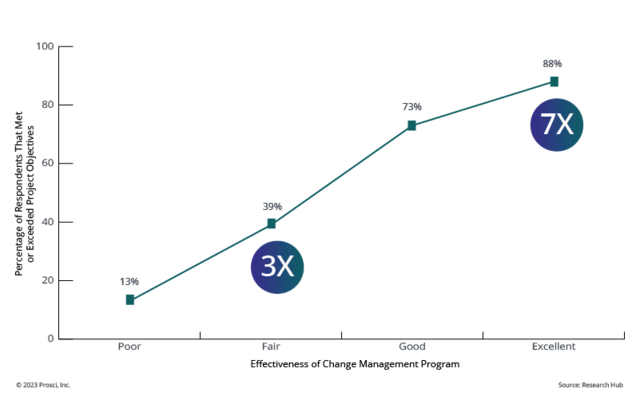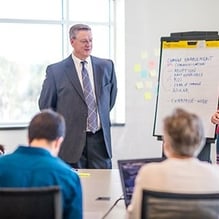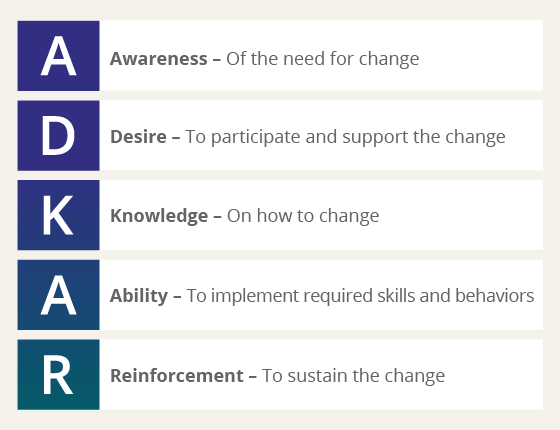How to Present Change Management to Executives

4 Mins
Updated: August 27, 2025
Published: February 27, 2019

Want to know how to engage your sponsors and increase their change management awareness? This high-level overview of change management for executives provides the fundamentals, which you can use to help sponsors begin to understand change management and its value for your organization.
What Is Change Management?
The technical definition of change management is, "the application of processes and tools to manage the people side of change from a current state to a new future state so that the desired results of the change are achieved." But a more compelling way to define change management is:
- Preparing, equipping and supporting individuals through the change journeys they experience as part of our organization so that results are achieved
- Capturing people-dependent return on investment
- Mobilizing people to deliver results
Why Is Change Management Necessary?
Various studies have shown that the likelihood that projects meet or achieve their objectives is directly related to change management effectiveness. Data from Prosci’s Best Practices in Change Management research shows that initiatives with excellent change management are 7X more likely to meet objectives than those with poor change management. Simply moving from “poor” to “fair” change management increases the likelihood of meeting objectives by 3X.
Participants from this study also identified lack of executive support and active sponsorship as the number one obstacle to success. Lack of engagement and advocacy from senior leaders, failure to remain active and visible throughout a project, and senior leaders opting out of change as barriers to engaging the organization grew are a few of the reasons participants cited.
Conversely, active and visible sponsorship was identified as the number one contributor to successful change management since Prosci began researching change management in 1998. Helping your executives understand and support change management is critical to the overall success of your initiatives.
Effect on adoption and usage
Applying change management can directly impact adoption and usage. Specifically, it can affect:
- Speed of adoption – how quickly the change is adopted into the organization and how well the project stays on schedule
- Utilization rate – the overall level of participation and ultimate utilization of the new processes, tools and job changes
- Proficiency – how well employees perform in the new environment and if they are achieving the expected performance levels
Effect on project objectives and ROI
When change management delivers targeted levels of adoption and usage, the probability that business objectives are achieved on time and on budget increases. When the people side of change is poorly managed, projects fall behind schedule, fewer employees engage in the change, and proficiency levels are lower. Projects deliver a lower ROI or in some cases fail completely.
Key Roles for Succeeding in Change Management
A discussion introducing change management would be incomplete without sharing the key roles in change management:
Primary sponsor
 The primary sponsor is the individual who authorizes and funds the project and is usually in control of the resources, systems and people that are affected by the change. The primary sponsor usually has the authority to determine the scope of the change and its timing. Employees want to see and hear the executive's commitment to the change. The authority they provide carries over to other change management roles.
The primary sponsor is the individual who authorizes and funds the project and is usually in control of the resources, systems and people that are affected by the change. The primary sponsor usually has the authority to determine the scope of the change and its timing. Employees want to see and hear the executive's commitment to the change. The authority they provide carries over to other change management roles.
People managers
Managers and supervisors who have employees affected by the change play a key role in helping their employees through the transition process. These people managers are the preferred sender of change messages related to how a change personally impacts employees.
Project team
The project team is tasked with managing the technical side of the change. In the end, they are the people who design how things will be done differently than they are today. The project team also plays a role in ensuring that change management is part of the project by providing the appropriate resources (budget and personnel) and time.
Change management resources or team

Dedicated change management resources provide focus and keep track of change management activities. They act as a point of responsibility and accountability. When budgets and schedules are squeezed, change management activities (communications, sponsorship, coaching, training and resistance management) are easily pushed to the bottom of the priority list if there are no dedicated resources.
Project support functions
Project support functions bring expertise in a particular area and enhance the execution of change management activities by bringing the broader organizational context to the table. HR business partners, training specialists and subject matter experts are just a few examples of project support functions.
Stakeholders
All sponsors, managers, supervisors and employees affected by the change are stakeholders. In many changes, external partners, vendors and even customers may be considered stakeholders. They all have a stake in the outcome of the change.
The Change Management Process
A holistic approach to change management on a project addresses both the organizational and individual change management processes:
Organizational change management
Organizational change management is a process for designing and implementing change management activities that affect broad groups of employees in order to enable adoption and proficient usage. This process is built in three phases that a project or change manager can work through for the changes and initiatives they are supporting. These phases include:
Phase 1: Prepare Approach

During this initial phase, practitioners prepare the change management approach to be applied across three stages:
- Define Success – What are we trying to achieve?
- Define Impact – Who has to do their jobs differently and how?
- Define Approach – What will it take to achieve success?
Phase 2: Manage Change

Next, practitioners develop specific plans to move impacted individuals and the organization through their ADKAR transitions, and learn how to measure, track and adapt performance. This is the longest phase timewise and where the majority of the change management team’s work is accomplished:
- Plan and Act – What will we do to prepare, equip and support people?
- Track Performance – How are we doing?
- Adapt Actions – What adjustments do we need to make?
Phase 3: Sustain Outcomes

Finally, the organization achieves the project’s benefits and focuses on sustaining the outcomes. Key activities take place in three phases:
- Review Performance – Now, where are we?
- Activate Sustainment – What is needed to ensure the change sticks?
- Transfer Ownership – Who will assume ownership and sustain the outcomes?
Individual change management
All change happens at the individual level. Individual change management prepares, equips and supports each person impacted by a change through their transitions. Based on the understanding that people experience change in predictable ways, the ADKAR Model represents the five elements a person must achieve all five elements to successfully transition through the change.

While all change happens at the individual level, it is impractical to manage changes and initiatives on a person-by-person basis. Organizational change management enables change at the individual level at scale and in a structured, repeatable way. It bridges the gap between individual change and organizational change, so the organization can achieve objectives.
Enterprise change management
Enterprise change management is the structured and intentional deployment of change management across and throughout an organization. Beyond applying change management effectively on individual projects, organizations with mature change capabilities make the management of change an organizational capability and a strategic, competitive advantage. Institutionalizing change management practices, processes, capabilities and competencies makes effectively managing the people side of change a core competency and cultural value of the organization. Building an intentional and repeatable strategy for change deployment enables an agile and change-ready organization.
Understanding Change Management
Effective change management enables your organization to achieve project objectives, capture the people-dependent portion of ROI, manage resistance, build change competency in the organization, and much more. When explaining change management to executives for the first time, sharing the what, why and how of change management is a great way to begin a meaningful conversation.



